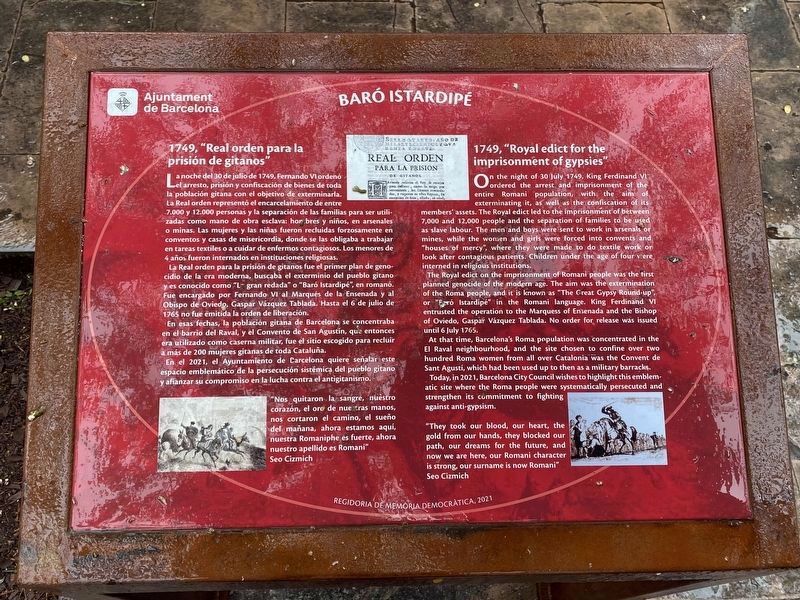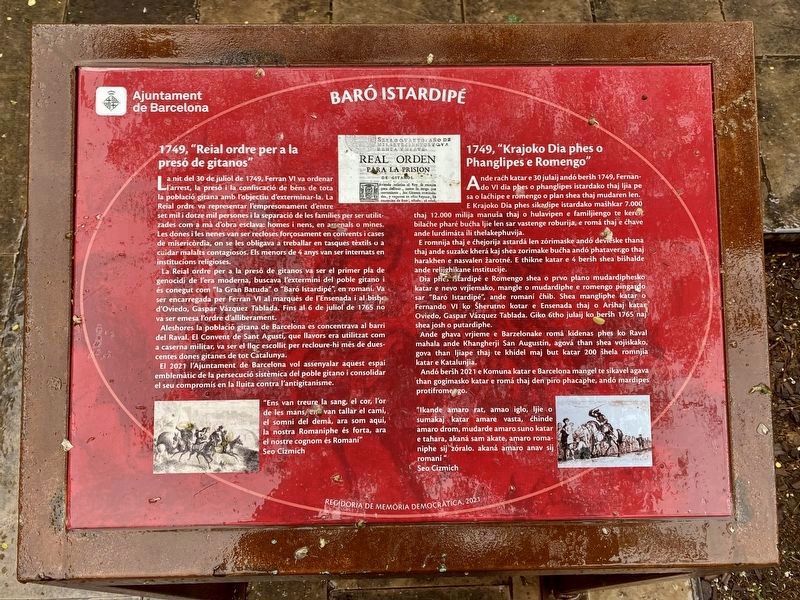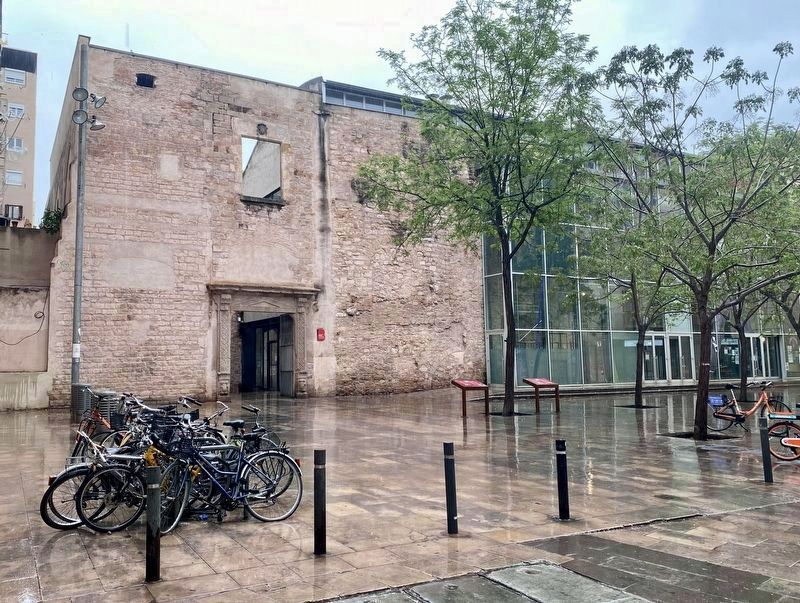Sant Pere in Barcelona, Catalonia, Spain — Southwestern Europe (Iberian Peninsula)
“The Great Gypsy Roundup” / Baró Istardipé
— Programes de Memòria —
Inscription.
1749, "Real orden para la prisión de gitanos"
La noche del 30 de julio de 1749, Fernando VI ordeno El arresto, prisión y confiscación de bienes de toda la población gitana con el objetivo de exterminarla. La Real orden representó el encarcelamiento de entre 7.000 y 12.000 personas y la separación de las familias para ser utilizadas como mano de obra esclava: hombres y niños, en arsenales o minas. Las mujeres y las niñas fueron recluidas forzosamente en conventos y casas de misericordia, donde se las obligaba a trabajar en tareas textiles o a cuidar de enfermos contagiosos. Los menores de 4 años fueron internados en instituciones religiosas.
La Real orden para la prisión de gitanos fue el primer plan de genocidio de la era moderna, buscaba el exterminio del pueblo gitano y es conocido como "La gran redada” o "Baró Istardipé", en romanó. Fue encargado por Fernando VI al Marqués de la Ensenada y al Obispo de Oviedo, Gaspar Vázquez Tablada. Hasta el 6 de julio de 1765 no fue emitida la orden de liberación.
En esas fechas, la población gitana de Barcelona se concentraba en el barrio del Raval, y el Convento de San Agustin, que entonces era utilizado como caserna militar, fue el sitio escogido para recluir a más de 200 mujeres gitanas de toda Cataluña.
En el 2021, el Ayuntamiento de Barcelona quiere señalar este espacio emblemático de la persecución sistémica del pueblo gitano y afianzar su compromiso en la lucha contra el antigitanismo.
“Nos quitaron la sangre, nuestro
corazón, el oro de nuestras manos,
nos cortaron el camino, el sueño
del mañana, ahora estamos aquí,
nuestra Romaniphe es fuerte, ahora
nuestro apellido es Romani"
Seo Cirmich
1749, "Royal edict for the imprisonment of gypsies"
On the night of 30 July 1749, King Ferdinand VI ordered the arrest and imprisonment of the entire Romani population, with the aim of exterminating it, as well as the confiscation of its members' assets. The Royal edict led to the imprisonment of between 7,000 and 12,000 people and the separation of families to be used as slave labour. The men and boys were sent to work in arsenals or mines, while the women and girls were forced into convents and “houses of mercy", where they were made to do textile work or look after contagious patients. Children under the age of four vere interned in religious institutions.
The Royal edict on
the imprisonment of Romani people was the first
planned genocide of the modern age. The aim was the extermination
of the Roma people, and it is known as "The Great Gypsy Roundup”
or “Baró Istardipé” in the Romani language. King Ferdinand VI
entrusted the operation to the Marquess of Ensenada and the Bishop
of Oviedo, Gaspar Vázquez Tablada. No order for release was issued
until 6 July 1765.
At that time, Barcelona's Roma population was concentrated in the El Raval neighbourhood, and the site chosen to confine over two hundred Roma women from all over Catalonia was the Convent de Sant Agustí, which had been used up to then as a military barracks. Today, in 2021, Barcelona City Council wishes to highlight this emblematic site where the Roma people were systematically persecuted and strengthen its commitment to fighting against anti-gypsism.
"They took our blood, our heart, the
gold from our hands, they blocked our
path, our dreams for the future, and
now we are here, our Romani character
is strong, our surname is now Romani"
Seo Cizmich
1749, "Reial ordre per a la presó de gitanos
La nit del 30 de juliol de 1749, Ferran VI va ordenar l’arrest, la presó i la confiscació de béns de tota la població gítana amb l'objectiu d'exterminar-la. La Reial ordre va representar
l'empresonament d'entre
set mil i dotze mil persones i la separació de les families per ser utilitzades com a mà d'obra esclava: homes i nens, en amenals o mines.
Les dones i les nenes van ser recloses forçosament en convents i cases
de misericordia, on se les obligava a treballar en tasques tèxtils o a
cuidar malalts contagiosos. Els menors de 4 anys van ser internats en
institucions religioses.
La Reial ordre per a la presó de gitanos va ser el primer pla de genocidi de l'era moderna, buscava l'extermini del poble gitano i és conegut com "la Gran Batuda” o "Baró Istardipé", en romani. Va ser encarregada per Ferran VI al marquès de l'Ensenada i al bisbe d'Oviedo, Gaspar Vázquez Tablada. Fins al 6 de juliol de 1765 no va ser emesa Fordre d'alliberament.
Aleshores la població gitana de Barcelona es concentrava al barri del Raval, El Convent de Sant Agustí, que llavors era utilitzat com a caserna militar, va ser el lloc escollit per recloure-hi més de dues- centes dones gitanes de tot Catalunya.
El 2021 l'Ajuntament de Barcelona vol assenyalar aquest espai emblemàtic de la persecució sistèmica del poble gitano i consolidar el seu compromís en la lluita contra l'antigitanisme.
"Ens van treure la sang, el cor, l'or
de les mans en van tallar el cami,
el somni del demà, ara som aquí,
la nostra Romaniphe és forta, ara
el nostre cognom és Romani"
Seo Cizmich
1749, "Krajoko Dia phes o Phanglipes e Romengo"
Ande raćh katar e 30 julaij andó beršh 1749, Fernando VI dia phes o phanglipes istardako thaj Ijia pe sa o laćhipe e romengo o plan shea thaj mudaren len. E Krajoko Dia phes sikadipe istardako mashkar 7.000 thaj 12.000 milija manula thaj o hulavipen e familiengo te kere bilache pharé bucha jie len sar vastenge roburija, e romá thaj e chave ande lurdimáta illi thelakephuvija.
E romnija thaj e thejorija astardá len zórimaske andó devike thana thaj ande suzake kherá kaj shea zorimake bucha andó phatavergo thaj harakhene nasvalen žarotné. E thikne katar e 4 berih shea bilhalde ande relighikane institucije.
Dia phes Istardipé e Romengo shea o prvo plano mudardiphesko katar e nevo vrjiemako, mangle o mudardiphe e romengo pingado sar "Baró Istardipé", ande romaní čhib. Shea mangliphe katar o Fernando VI ko Šherutno kotar e Ensenada thaj o Aršhaj katan Oviedo, Gaspar Vázquez Tablada. Giko 6tho julaij ko beršh 1765 naj shea josh o putardiphe.
Ande ghava vrjieme e Barzelonake romá kidenas phes ko Raval mahala ande Khangherji San Augustin, agová than shea vojiskako. gova than Ijiape thaj te khidel maj but katar 200 hela romnjia katar e Katalunjia.
Andó berih 2021 e Komuna katar e Barcelona mangel te sikavel agava than gogimasko katar e romá thaj den piro phacaphe, andó mardipes protifromengo.
“Ikande amaro rat, amao iglo, jie o
sumakaj katar amare vasta, ćhinde
amaro drom, mudarde amaro suno katar
e tahara, akaná sam akate, amaro roma-
niphe sij zóralo. akaná amaro anav sij romani”
Sea Cizmich
Erected 2021 by Ajuntament de Barcelona.
Topics and series. This historical marker is listed in these topic lists: Civil Rights • Notable Events. In addition, it is included in the Barcelona Programes de Memòria series list. A significant historical date for this entry is July 30, 1749.
Location. 41° 23.259′ N, 2° 10.858′ E. Marker is in Barcelona, Cataluña (Catalonia). It is in Sant Pere. Marker is on Carrer d'en Tantarantana, on the right when traveling north. Touch for map. Marker is in this post office area: Barcelona, Cataluña 08003, Spain. Touch for directions.
Other nearby markers. At least 8 other markers are within walking distance of this marker. Madrona Clarina y Colomer (a few steps from this marker); Monestir de Sant Pere de les Puelles (approx. 0.3 kilometers away); Siege of Barcelona (approx. 0.4 kilometers away); Barcelona Holocaust Memorial (approx. 0.4 kilometers away); Miquel Llobet (approx. 0.4 kilometers away); The Murder of Sònia Rescalvo Zafra (approx. half a kilometer away); Martyrs of 1714 Memorial (approx. half a kilometer away); Lyceum Club de Barcelona (approx. half a kilometer away). Touch for a list and map of all markers in Barcelona.
Also see . . .
1. Great Gypsy Round-up (Wikipedia).
Overview: The Great Gypsy Round-up (Spanish: Gran Redada de Gitanos also known as the general imprisonment of the Gypsies (prisión general de gitanos) was a raid authorized and organized by the Spanish Monarchy that led to the arrest of most Roma in the region and the genocide of 12,000 Romani people. Although a majority were released after a few months, many others spent several years imprisoned and subject to forced labor. The raid was approved by the King Ferdinand VI of Spain, and organized by the Marquis of Ensenada, and set in motion simultaneously across Spain on July 30, 1749.(Submitted on February 20, 2023.)
2. Shedding light on a dark episode. The Great Gypsy Round-up (Museu Virtual del Poble Gitano…).
What made the Great Round-up possible?: From 1633, the existence of Roma as such was officially denied, a fact that can be documented in legislation. In 1695 a process of municipal registration was begun requiring Roma to register as New Castilians and not as Roma. They were obliged to divulge in which town they lived. Failure to do so would lead to them to be punished as galley slaves. To avoid being punished through imprisonment, they had to subject themselves to local control. In 1717 a Pragmatic Decree was issued specifying 41 cities where Roma would have to live. They would only be allowed to live in these cities and, of course, were required to be officially registered. In 1646, another Pragmatic Decree was issued to enforce the obligation of Roma to register for local censuses. In addition, another 34 cities were added and Roma who registered in them were subjected to strict surveillance…Thus, the Great Round-up of 1749 could not have been possible without that compilation of data, or without the new strategy of controlling those belonging to the Roma culture. It would have been absolutely impossible. Such measures enabled the existence in 1749 of a listing of 14,000-20,000 Roma people in 54 Spanish cities with details of exactly where and who they were. And that is what made the Great Round-up possible.(Submitted on February 20, 2023.)
Credits. This page was last revised on February 20, 2023. It was originally submitted on February 20, 2023, by Andrew Ruppenstein of Lamorinda, California. This page has been viewed 175 times since then and 45 times this year. Photos: 1, 2, 3. submitted on February 20, 2023, by Andrew Ruppenstein of Lamorinda, California.


